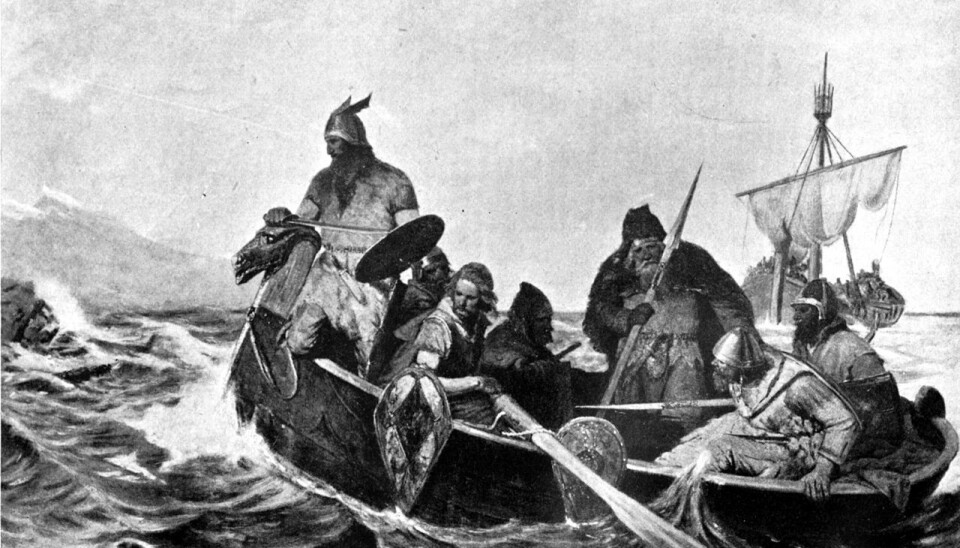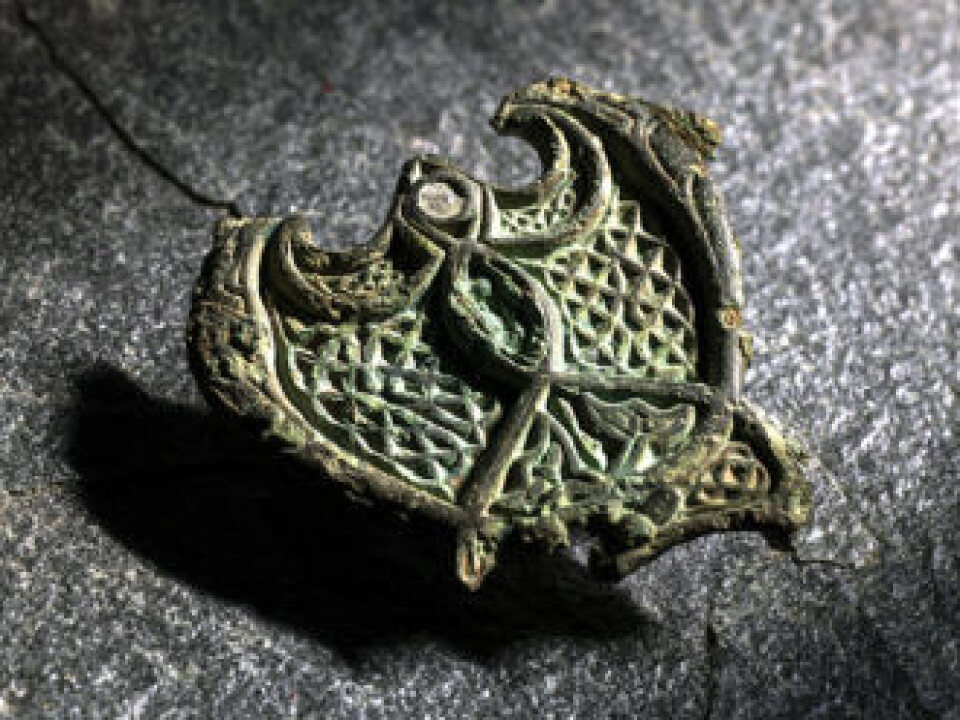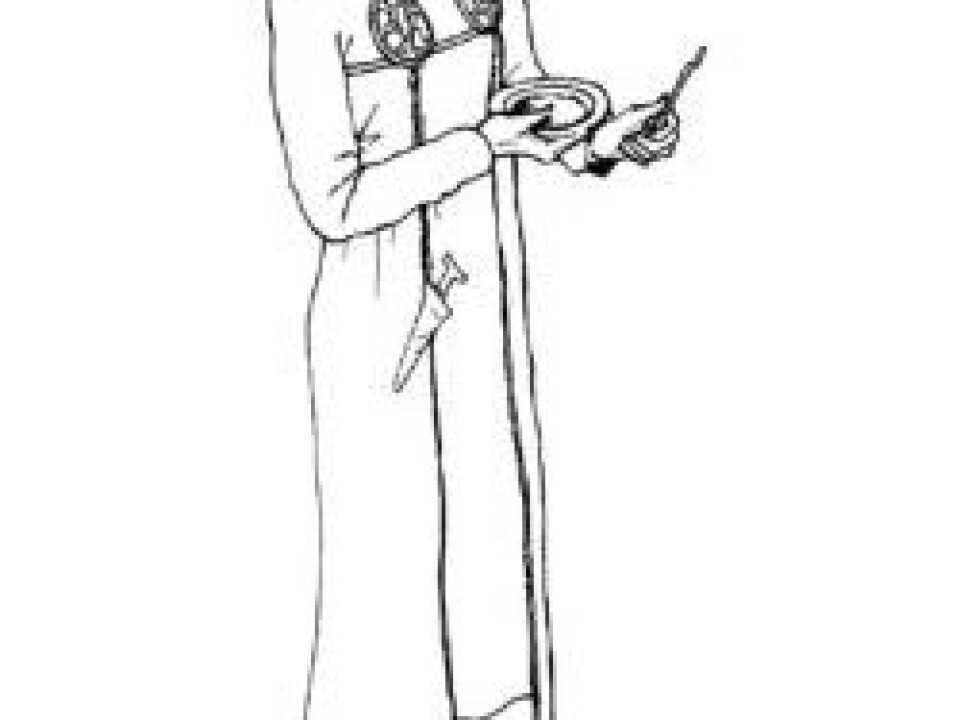An article from Norwegian SciTech News at NTNU

Dressed up with jewellery stolen in Viking raids
We might not consider it bling, but to the Viking-age woman who wore a fitting from a horse’s harness, it was an exotic piece of jewellery. Never mind that it was stolen from the British Isles during a Viking raid.
When a female Norwegian Viking died some time during the 9th century, she was buried wearing a status symbol: a beautiful piece of bronze jewellery worn on her traditional Norse dress.
In the summer of 2016, 1200 years after her death, the piece of jewellery was found by chance at Agdenes farm, at the outermost part of the Trondheim Fjord in Mid-Norway. The well-preserved object is an ornament with a bird figure that has fish- or dolphin-like patterns on both “wings”.
The decorations suggest that the jewellery was made in a Celtic workshop, most likely in Ireland, in the 8th or 9th century. It was originally used as a fitting for a horse’s harness, but holes at the bottom and traces of rust from a needle on the back show that it had probably been turned into a brooch at a later stage.
But how did a fitting from an Irish horse’s harness end up as a brooch for a Norwegian Viking woman?
Took the jewellery to her grave

Aina Margrethe Heen Pettersen is a doctoral student at NTNU’s Department of Historical Studies and works with finds brought to Norway during the Viking age.
She will now study the bronze brooch more closely, which has been curated and preserved by the NTNU University Museum.
She explains that fittings like this were popular among Norwegian Vikings who took part in the first raids to the British Isles, at the very beginning of the Viking age.
The fittings were originally attached to horse harnesses, like in this case, or to religious items such as books, crosiers or altar decorations.
Viking woman in traditional clothing

The men who returned alive from the dangerous Viking raids gave the fittings they had stolen to female family members who waited for them at home.
The fittings were then turned into garment jewellery, worn on traditional Norse clothing as brooches, pendants or belt fittings. Illustration: Roger Simpson, Northern Archaeological Associates
“A housewife in Mid-Norway probably received the fitting as a gift from a family member who took part in one or more Viking raids to Ireland or Great Britain. When she died, the jewellery was given to her as a burial gift. It has stayed underground until it was found by chance this summer,” Heen Pettersen says.
She adds that almost all of the similar finds from this era that have been discovered in Norway have been found in women’s graves that date from the first half of the 9th century, when the Vikings began to plunder the British Isles.
Visual status symbols
Being part of the early Viking raids brought status and prestige to the individuals who participated, but also to their families.
The men who returned alive from the dangerous journeys gave the objects they had stolen as gifts to female family members who waited for them at home. The fittings were then turned into jewellery, and were worn on traditional Norse clothing as brooches, pendants or belt fittings.
“As a result, it became clear to everyone that those women had family members who had taken part in successful expeditions far away. There are traces of gold on the surface of the jewellery, so it was originally covered in gold. That made it appear more valuable than it actually was. In addition, each piece of jewellery was unique, so the owner did not risk having the housewife next door turn up with the same piece of jewellery,” Heen Pettersen says.
Jewellery of this kind has typically been found in women’s graves with relatively few other burial gifts. This suggests that many of the Vikings who took part in raids far away did not represent the top layer of the social hierarchy. Instead, they were “nouveau riche” farmers and fishermen who got the opportunity to climb the social ladder by taking part in Viking raids.
Strategic location
Agdenes is strategically located at the south end of the mouth of the Trondheim Fjord, where it meets the Trondheimsleia Strait. The place is mentioned several times in the Norse sagas as a gathering place where ships with warriors met before the journey continued.
Traces of King Øystein’s Harbour, which was established for military and defense reasons early in the 12th century, are found just next to Agdenes farm, where the bronze brooch was discovered.
The harbour validates the strategic location of the place. It is possible that the area served as a natural gathering or stopping place for ships sailing from Trondheim Fjord to the British Isles.
From Mid-Norway, ships probably followed the coastline southwards before they crossed the open ocean across the North Sea.
If the weather was nice and the wind came from the right direction, they could sail from the southwest of Norway to the east coast of England or Scotland in just a couple of days.
If they were surprised by bad weather, the journey could be fatal.
The grave has been disturbed
According to Heen Pettersen, the bronze brooch was found by a private individual with a metal detector, so it is not a find from an archaeological site.
The jewellery was not found in the original grave, which indicates that the grave at some point had been disturbed – for example during ploughing or other farming activities.
The Viking women who owned this kind of jewellery were typically buried with grave gifts such as tortoise-shaped brooches, pearls, a knife and a spinning wheel, in addition to jewellery made from stolen fittings.
“The new find from Agdenes farm shows that the area was populated in the first part of the Viking Age. Even though it is a random find, it is a nice reminder that Mid-Norway was involved in the early contact with the British Isles,” says Heen Pettersen.
































